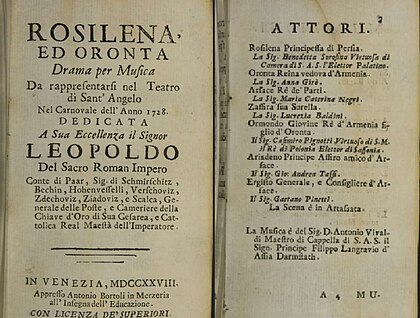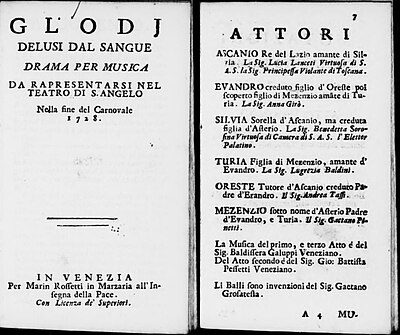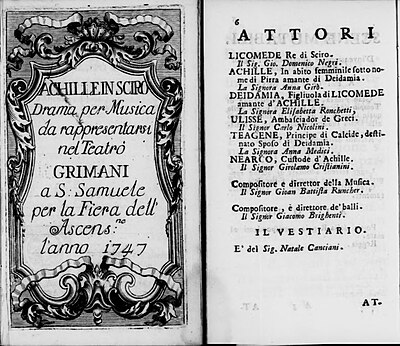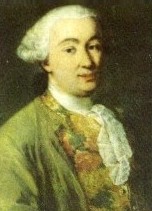Loading AI tools
Anna Girò (also Girrò or Giraud), also known as l'Annina del Prete Rosso, la Nina del Prete Rosso, or l'Annina della Pietà, was the stage name of Anna Maria(?) Maddalena Tessieri (or Tesieri, Teseire or Testeiré), an Italian mezzo-soprano/contralto of the 18th century. She is best remembered for her numerous collaborations with composer Antonio Vivaldi who wrote operatic roles for her. She is the singer who performed the greatest number of Vivaldi's operas, the one who kept them in her repertoire the longest time and who made them known across the largest geographical area.[1]
Mantua
Girò was born in Mantua in 1710 or a few years earlier. She was the daughter of a wig maker of French descent called Pietro, whose surname Giraud was made into Girò in italian and passed onto the offspring in its italianized graphy. Her mother was Bartolomea, widow of Giacomo Trevisan.[1]

Venice
At twelve she was sent to Venice to study singing. There, she was welcomed by her half-sister Paolina who was twenty years her senior and already a resident there. (Paolina assisted Anna throughout her career.)[2] Still very young, Girò made her debut in Treviso in 1723 and in Venice in 1724. She first sang roles en travesti and soon female roles followed. With her musical and acting talents she conquered the Venetian Opera Stage in a single year.[1]She soon started a close professional collaboration with Antonio Vivaldi. She had been his student, was now his protégée, and soon would be his favorite prima donna.[3]
Meeting Vivaldi
Girò may have become acquainted with Vivaldi during his time in Mantua between 1718 and 1720. She was then an aspiring young singer and she may have been his student there.[3] In any case, it is fair to assume that she would have met Antonio Vivaldi and sang some of his music for the first time between 1720 and 1723, as, by then, she was a student at the famous Ospedale della pietà,[4][5][6] an "orphanage-cum-conservatoire where he was composer in residence".[7] Vivaldi had recently been promoted to the specially created office of Maestro de' Concerti and was in charge of the Figlie di Choro (the musicians), the élite of the Pietà. It is not clear though how Girò was enrolled for the Pietà was "a home for abandoned and unwanted babies, not (as is often stated) a convent or a school for girls".[8] Part of Vivaldi's job was to train those girls to sing and play instruments during services at La Pietà. Under his direction the choro became so famous that they attracted visitors from across Europe and a visit to the Pietà had become a feature of the Grand Tour.[8] (Vivaldi wrote many works for the girls of this establishment (and of course when Girò was a student there), including, for instance, the Kyrie RV587, the Dixit RV594, the Domine RV593 etc.).
Dorilla in Tempe
Dorilla in Tempe, which premiered at the Teatro Sant' Angelo in Venice on 9 November 1726, was the first opera by Vivaldi to include Girò in its cast. In this opera she sings the role of Eudamia, the seconda donna. The arias written for her by Vivaldi were made to fit her singing abilities perfectly.[9] (Her voice was not strong, but she was attractive and acted well.)[10] For Girò – who will go through thick and thin with him for a long time – he gives priority to sincerity over virtuosity. The captivating aria "Al mio amore il tuo risponda" from act 1, scene 8, which she would have performed for the first time here, would be included in other future operas.[9][11] The plaintive "Il povero mio core"from act 3, scene 4 🎼, although interpreted by Angela Capuano as Dorilla at the premiere, was reprised by Girò as an aria di baule that she would sing throughout her career. (The arie di baule or "suitcase arias" are an integral part of the traveling singers' luggage. They had them ready at every opportunity.)[9][11]Dorilla in Tempe was well received and became especially popular with its choirs and ballets.[11] It also became one of Vivaldi's personal favorites. Girò appeared in nearly all his operas after that.[12]

Performances in chronological order
| Year | City | Work | Composer | Role | Male / female role | Premiere or revival | Additional notes |
|---|---|---|---|---|---|---|---|
| 1723 | Treviso | La ninfa infelice e fortunata | Giuseppe Boniventi. (Completed by Giacomo Maccari and Antonio Vivaldi.)[1] | Mirtillo[14] | M | premiere |  |
| 1724 | Venice | Laodice | Tomaso Albinoni | Clistene[15] | M | premiere | |
| 1724 | Venice | Il nemico amante | Giuseppe Maria Buini, Fortunato Chelleri,[1] Antonio, K. Di Gaspari (?)[16] | Idalma[16] | F | revised version | pasticcio (?) |
| 1725 | Venice | Agide re di Sparta | Giovanni Porta | Filoastro[17] | M | premiere |  |
| 1725 | Venice | Li sdegni cangiati in amore | Giuseppe Maria Buini | Evanco[18] | M | premiere | |
| 1726 | Venice | Dorilla in Tempe | Antonio Vivaldi | Eudamia | F | premiere |  |
| 1726 | Venice | Medea e Giasone | Francesco Brusa | Isifile[19] | F | premiere | |
| 1727 | Venice | Farnace | Antonio Vivaldi | Tamiri | F | premiere | |
| 1727 | Milan | Tamerlano | Giovanni Antonio Giaì | Irene[20] | F | premiere | |
| 1727 | Venice | Orlando Furioso | Antonio Vivaldi | Alcina | F | premiere | |
| 1728 | Venice | Rosilena ed Oronta | Antonio Vivaldi | Oronta[21] | F | premiere |  |
| 1728 | Venice | Gl'odi delusi dal sangue | Baldassare Galuppi and Giovanni Battista Pescetti. (Galuppi wrote the music for acts 1 and 3, whilst Pescetti wrote the music for act 2.) | Evandro[23] | M | premiere |  |
| 1728 | Bologna | Teodorico | Giuseppe Maria Buini[24] | Clotilde[24] | F | premiere | |
| 1729 | Florence | L'Atenaide | Antonio Vivaldi | Pulcheria | F | premiere | |
| 1729 | Florence | Catone in Utica | Leonardo Vinci | Emilia[25] |
F | revival |  |
| 1730 | Milan | Ezio | Luca Antonio Predieri[1](?),
Giuseppe Ferdinando Brivio[27] (?) |
Onoria[27] | F | premiere | pasticcio (?) |
| 1730 | Milan | Semiramide riconosciuta | Geminiano Giacomelli | Tamiri[28] | F | premiere | |
| 1730 | Venice | Dalisa | Johann Adolf Hasse | Edita[29] | F | premiere | Girò shared the stage with two stars: Faustina Hasse (Bordoni) and Angelo Amorevoli. |
| 1731 | Turin | Ezio | Riccardo Broschi | Onoria | F | premiere |  |
| 1731 | Turin | Poro | Nicola Porpora | Erissena[30] | F | premiere | This production had the exact same star-studded cast as Riccardo Broschi's Ezio, produced also in Turin in 1731. |
| 1731 | Pavia | Farnace | Antonio Vivaldi | Tamiri | F | revival | |
| 1732 | Mantua | Semiramide | Antonio Vivaldi | Semiramide | F | premiere | |
| 1732 | Mantua | Farnace | Antonio Vivaldi | Tamiri | F | revival | |
| 1733 | Venice | Motezuma | Antonio Vivaldi | Mitrane | F | premiere | |
| 1734 | Verona | Lucio Papirio dittatore | Geminiano Giacomelli | Papiria[31] | F | revival | role originally created by Faustina Bordini in 1729[32] |
| 1734 | Verona | Arsace | Giuseppe Maria Orlandini | Statira | F | revival | |
| 1735 | Verona | L'Adelaide | Antonio Vivaldi | Adelaide[33] | F | premiere |  |
| 1735 | Verona | Tamerlano aka Bajazet | Antonio Vivaldi | Asteria | F | premiere | pasticcio |
| 1735 | Venice | Griselda | Antonio Vivaldi | Griselda | F | premiere |  |
| 1736 | Florence | Cesare in Egitto | Geminiano Giacomelli | Cornelia[37] | F | new setting | re-arranged by Giuseppe Maria Orlandini and later by Antonio Vivaldi |
| 1736 | Florence | Ginevra principessa di Scozia | Antonio Vivaldi | Ginevra | F | premiere | |
| 1737 | Ferrara | Demetrio | Johann Adolph Hasse | Cleonice[38] | F | revival | |
| 1737 | Ferrara | Alessandro nell'Indie | Antonio Vivaldi and Johann Adolph Hasse | Cleofide | F | pasticcio based on Johann Adolph Hasse's music or new setting by Hasse (?) | |
| 1737 | Verona | Catone in Utica | Antonio Vivaldi | Marzia | F | premiere | |
| 1738 | Venice | L'oracolo in Messenia | Antonio Vivaldi | Merope | F | premiere | |
| 1738 | Venice | Armida al campo d'Egitto | Antonio Vivaldi | Armida[39] | F | revised version | |
| 1738 | Venice | Rosmira | Antonio Vivaldi | Rosmira
/Eurimene[40] |
F | premiere | pasticcio |
| 1738[41] | Ancona | Siroe re di Persia | Antonio Vivaldi | Emira[41] | F | revival | |
| 1739 | Ferrara | Siroe re di Persia | Antonio Vivaldi | Emira | F | revival | |
| 1739 | Ferrara | Attalo re di Bitinia | Johann Adolph Hasse | Arsinoe[42] | F | revival | |
| 1739 | Graz | Ciro riconosciuto | ? | Mandane[43] | F | ? | |
| 1739 | Graz | Rosmira | Leonardo Vinci | Rosmira[44] | F | revival | pasticcio |
| 1739 | Graz | Lucio Papirio dittatore | Francesco Zoppis ("other composers: AA. and VV.") | Papiria | F | premiere | pasticcio (?) |
| 1740 | Graz | Catone in Utica | Antonio Vivaldi | Marzia | F | revival | |
| 1740 | Graz | Amor, odio e pentimento | Giovanni Porta | Arnea | F | revival | |
| 1742 | Vienna | L'oracolo in Messenia | Antonio Vivaldi | Merope (?) | F | revival | Posthumous production (Vivaldi died in 1741) |
| 1743 | Venice | Ezio | Giovanni Battista Lampugnani | Fulvia[45] | F | revival | |
| 1745 | Milan | Ricimero | Baldassare Galuppi | Ediuge[46] | F | premiere | |
| 1745 | Milan | L'Ipolito | Christoph Willibald Gluck | Fedra[47] | F | premiere |  |
| 1746 | Brescia | Alessandro nell'Indie | Pietro Pellegrini | Cleofide (as "Anna Maria Girò") | F | premiere | |
| 1747 | Venice | Achille in Sciro | Giovanni Battista Runcher | Achille[48] | M dressed as F | premiere |  |
| 1748 | Piacenza | Artaserse | Giuseppe Carcani | Mandane | F | premiere |
Vivaldi's and Girò's professional collaboration in figures
(Based on the information available to us – see above table)
1. From their first premiere together to their last:
- 12 years span
- 14 original productions (including premieres). i.e. 14 roles written by Vivaldi specifically for Girò.
2. From their first show together to their last:
- 15 years span
- 22 productions (including revivals and revised versions)
3. Their collaboration represents 15 years out of:
- 21 years (Girò). (length of her career whilst Vivaldi was alive)
- 18 years (Vivaldi) (length of his opera career whilst Girò was active professionally)
4. Their partnership lasted until the very death of the composer in 1741, or very close to it.
This sort of long and fruitful professional collaboration is unheard of concerning Vivaldi. And generally speaking, it was rather uncommon. For instance, Senesino, whom we consider as closely associated with George Frideric Handel for the many famous operas they collaborated on, spent 13 years working with Handel, out of 33 years (length of his career whilst Handel was alive). Together they created 16 roles and collaborated on 3 revivals.[49] Finally, they stopped their partnership 7 years before the death of the composer.
With the exception of Alderano Cybo-Malaspina, Duke of Massa and Carrara (who in 1725, through Vivaldi, gave her money for the purchase of a harpsichord), Girò seems to have always worked without depending on patrons.[1] (Alderano dissipated the assets and heritage accumulated by the Cybo dynasty, including the Duchy of Massa and Carrara itself.[50])
In 1741, on his way to Vienna where he wished to take up the position of a composer in the imperial court, Vivaldi may have stopped in Graz to see Girò,[51] and she likely went with him on his journey.[1] Her schedule seems to support this theory as the records show that she was in Graz in 1740 and 1741 and then in Vienna in 1742. Vivaldi was hoping to make a fresh start in Vienna. However his asthma, exhaustion and the death of the music-loving Emperor Charles VI, one of his great admirers, put an end to the project before it had even begun, and the composer died on 28 July of the same year at the age of 63.[11]
In 1748, while on tour in Piacenza, Girò met Count Antonio Maria Zanardi Landi, a local nobleman. He followed her back to Venice and persuaded her to marry him, despite the disparity of their conditions. They married in secret on 20 July 1748 in Venice.[2]: 32–41 From 1748, there are no more records of her. She possibly retired from the stage and moved to Piacenza.[1] There is no record of her death, so it is not known when and where she died.

Speculations
Vivaldi's contemporaries and modern scholars have speculated on the nature of the composer's and Girò's relationship, but no evidence exists to indicate anything beyond friendship and professional collaboration. Vivaldi in fact adamantly denied any romantic relationship with Girò in a letter to his patron Bentivoglio dated 16 November 1737.[52]
All'Ospedale della Pietà
In 2008, Susan Orlando – director of the Vivaldi Edition for Naïve/Opus 111 – writes in The Guardian: "From 1703 to 1735, Vivaldi .. played the role of music master and composer to the young girls living at La Pietà. Imagining Vivaldi ... in a role of both authority and intimacy among these vulnerable young women, has seduced writers and film-makers into fantasising about the erotic potential of the scenario. It is easy to imagine a libidinous red-haired priest exploiting the privileges of the cloth, in an institution that even 17th- and 18th-century visitors described with thinly veiled salaciousness. ... [But with regard to] illicit affairs, we have nothing to go on."[12]

A priest's Perpetua
S. Orlando continues: "A better documented trail leads to Vivaldi's muse, Anna Giro. [sic.] In 1724, this promising young singer and her elder half-sister, acting as chaperone, moved in with Vivaldi. ... She was closely affiliated with him until the end of his life. Again, the titillating image of a 'loose' priest comes up. In truth, this arrangement may not have been so shocking in an age in which priests traditionally maintained a life-long, live-in perpetua – a woman who dedicated her time to the priest as cook, house cleaner and general companion. But Anna held a special place in Vivaldi's heart; in opera after opera he wrote roles specifically for her, moulding the music to her particular vocal strengths and weaknesses. No other singer received such consistent attention and privilege from the composer. In 1738 Vivaldi was refused entrance to the city of Ferrara where his opera Farnace was to be performed. The city's new cardinal was making a moral point – his disapproval of a priest involved in the frivolities of the operatic world and living under the same roof as a female singer. These are the scant facts we have to go on ... But Vivaldi consistently denied any wrongdoing."[12]
Goldoni's account and the Virgin Mary
Letting us draw our own conclusions, S. Orlando tells us two anecdotes: "Carlo Goldoni [the famous Venetian playwright who collaborated with him on his opera Griselda] has left us a vivid description of his first meeting with Vivaldi in 1735. He arrived to find the composer engrossed in meditational reading and describes him clutching his missal throughout the interview – signs of, at the very least, a modicum of religious conviction. ... To this should be added that Vivaldi signed many of his music scores, especially but not exclusively the operas and sacred music, with an extravagant dedication to the Virgin Mary."[12]
Cinema
- In the 1989 Franco-Italian fictional comedy-thriller Venetian Red (Rouge Venise / Rosso Veneziano) directed by Etienne Périer, Girò ("La Girò") is played by actress Catherine Lachens.[53]
- In the 2006 French fictional drama Antonio Vivaldi, Un Prince à Venise directed by Jean-Louis Guillermou, Girò is played by actress Annette Schreiber and her sister is played by actress Diana Fertikh.[54]
Books (fiction)
Many roles once sung or created by Girò have been interpreted and recorded by mezzo-sopranos, contraltos or countertenors. The musical links below (🎼) will take you to audio recordings of some of Girò's arias that survived the centuries.
- Vinci. Catone in Utica Emilia: Vince Yi. Riccardo Minasi, Il pomo d'oro. Decca 01588194. 2015. 🎼
- Vivaldi. Armida all Campo d'Egitto Armida: Sara Mingardo. Rinaldo Alessandrini, Concerto Italiano. Naïve/Opus111 OP30492. 2010 🎼
- Vivaldi. Atenaide Pulcheria: Guillemette Laurens. Federico Maria Sardelli, Modo Antiquo. Naïve/Opus111 Vivaldi Edition OP30438. 2007 🎼
- Vivaldi. Bajazet Asteria: Marijana Mijanović. Fabio Biondi, Europa Galante. Virgin VCDW 545676-2. 2005 🎼
- Vivaldi. Catone in Utica Marzia: Liliana Faraon. Jean-Claude Malgoire. La Grande Ecurie et la Chambre du Roy. Dynamic 403/1-2. 2002 🎼
- Vivaldi. Catone in Utica Marzia: Sonia Prina. Alan Curtis, Il Complesso Barocco. Naïve OP30545. 2013 🎼
- Vivaldi. Dorilla in Tempe. Eudamia: Consuelo Caroli. Gilbert Bezzina, Ensemble Baroque de Nice. Pierre Verany PV794092. 1994 🎼
- Vivaldi. Dorilla in Tempe. Eudamia: Sonia Prina. Diego Fasolis, I Barocchisti. Opus111/Naïve. OP30560. 2017 🎼
- Vivaldi. Farnace Tamiri: Ruxandra Donose. Diego Fasolis, I Barocchisti. Virgin Classics 2011 🎼
- Vivaldi. Farnace Tamiri: Sara Mingardo. Jordi Savall, Le Concert Des Nations. Opus111/Naïve. OP30471. 2009
- Vivaldi. Griselda Griselda: Marie-Nicole Lemieux. Jean-Christophe Spinosi, Ensemble Mattheus. Opus111/Naïve OP30419. 2006 🎼
- Vivaldi. Griselda Griselda: Caitlin Hulcup. Erin Helyard, Orchestra of the Antipodes. Pinchgut Live PG002. 2011 🎼
- Vivaldi. Griselda Griselda: Marion Newman. Kevin Mallon, Aradia Ensemble. Naxos 8.660211-13. 2008 🎼
- Vivaldi. Motezuma Mitrena: Marijana Mijanović. Alan Curtis, Il Complesso Barocco. DG-Archiv 477 599–6. 2006 🎼
- Vivaldi. Orlando furioso. Alcina: Jennifer Larmore. Jean-Christophe Spinosi, Ensemble Mattheus. Opus111/Naïve OP30393. 2004 🎼
- Vivaldi. Orlando furioso. Alcina: Marina de Liso. Federico Maria Sardelli, Modo Antiquo. cpo 777095-2. 2008 🎼
- Vivaldi. Rosmira Rosmira: Marianna Pizzolato. Gilbert Bezzina, Ensemble Baroque de Nice. Dynamic CDS437/1-3. 2003 🎼
- La Ninfa Infelice e Fortunata. This pasticcio is likely to have reused a number of arias from Vivaldi's La Verità in Cimento. It marked the operatic debut of Girò. Frédéric Delaméa writes in the liner notes to the Naïve/Opus 111 recording of La Verità in Cimento (OP 30365. 2003) that it "bears the stamp" of Vivaldi.[57]
Wikiwand in your browser!
Seamless Wikipedia browsing. On steroids.
Every time you click a link to Wikipedia, Wiktionary or Wikiquote in your browser's search results, it will show the modern Wikiwand interface.
Wikiwand extension is a five stars, simple, with minimum permission required to keep your browsing private, safe and transparent.